
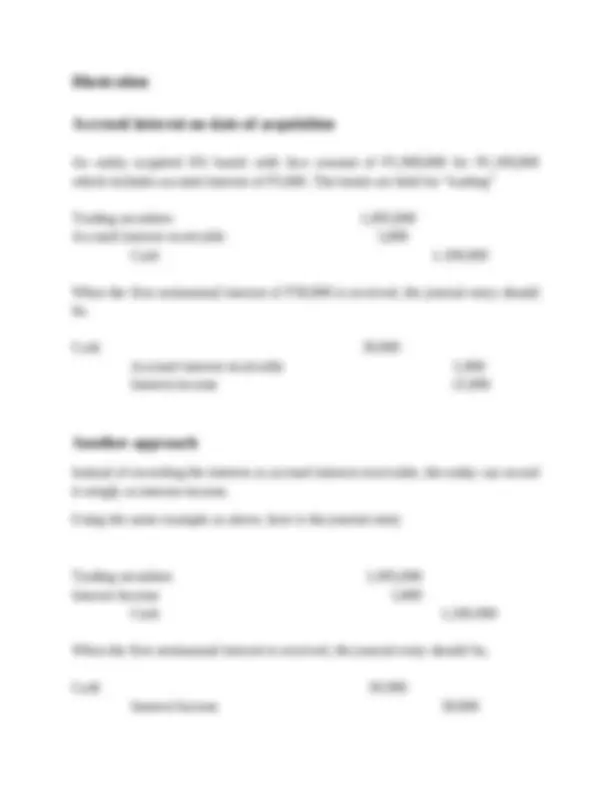
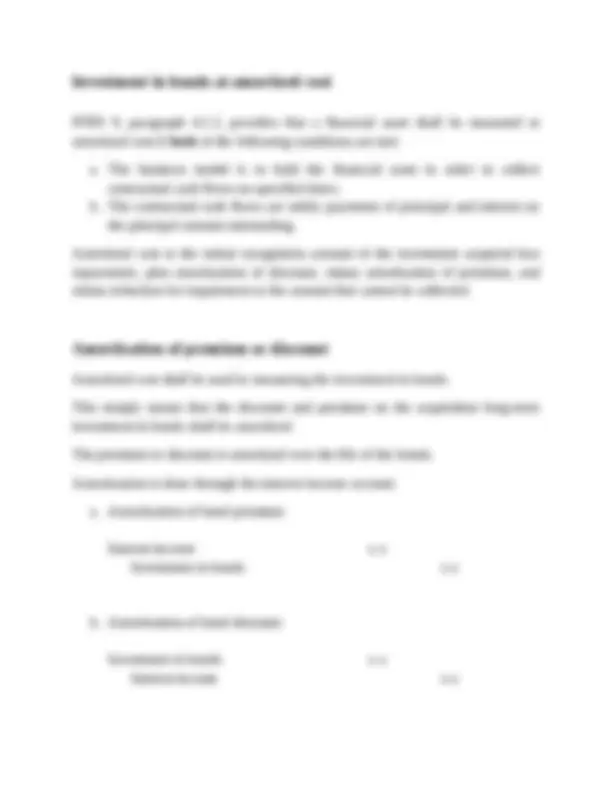
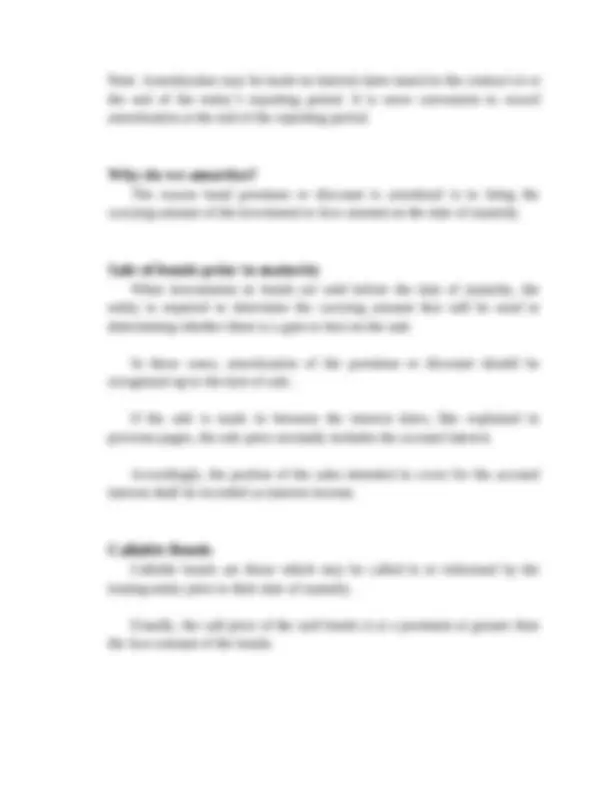
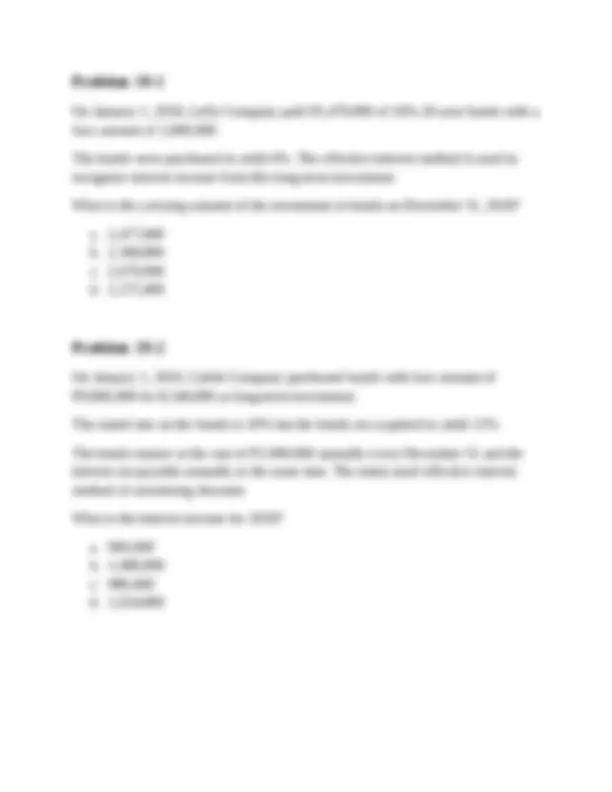
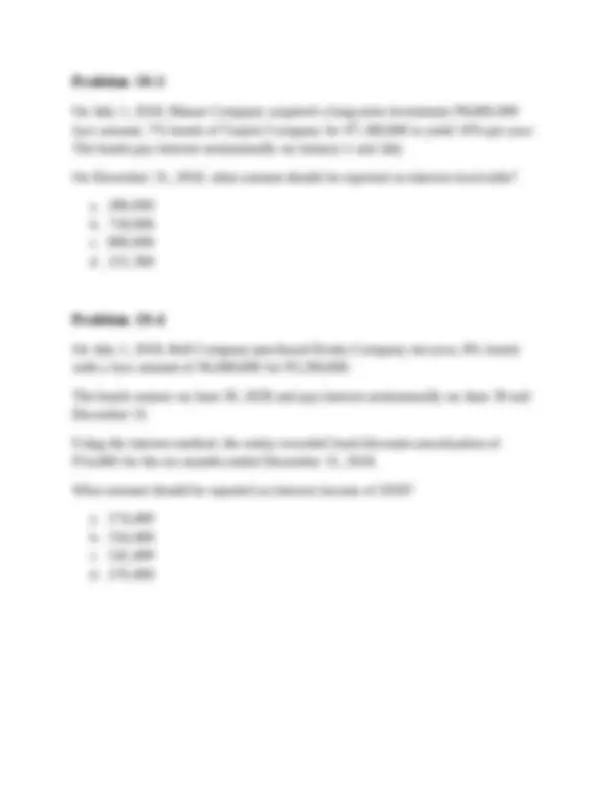


Study with the several resources on Docsity

Earn points by helping other students or get them with a premium plan


Prepare for your exams
Study with the several resources on Docsity

Earn points to download
Earn points by helping other students or get them with a premium plan
Community
Ask the community for help and clear up your study doubts
Discover the best universities in your country according to Docsity users
Free resources
Download our free guides on studying techniques, anxiety management strategies, and thesis advice from Docsity tutors
The definition of bond investment, its classifications, interest payment dates, initial and subsequent measurement, acquisition of bond investment, amortization, sale of bonds prior to maturity, callable bonds, convertible bonds, serial bonds, and term bonds. It also discusses the methods of amortization and provides true or false theories related to bond investment and accounting. useful for students studying finance, accounting, or business management.
Typology: Lecture notes
1 / 9

This page cannot be seen from the preview
Don't miss anything!






A bond is a formal unconditional promise made under the law to pay a specified sum of money at a determined future date, and make a periodic interest payment at a stated rate until the principal amount is paid. A bond is evidenced by a certificate and an agreement between the issuer and the investor.
The interest on bond investments is usually paid every six months or semi- annually. The dates are as follows: a. January 1 and July 1 d. April 1 and October 1 b. February 1 and August 1 e. May 1 and November 1 c. March 1 and September 1 f. June 1 and December 1 Note: There are interests that is only paid every annually or once a year.
Bonds can be a current or a noncurrent investment depending on the model of business. Accordingly, bond investments are classified and accounted for as follows:
a. Financial asset held for trading b. Financial asset at amortized cost c. Financial asset at fair value through other comprehensive income d. Financial asset at fair value through profit or loss by irrevocable designation or by fair value option Initial measurement PFRS 9, paragraph 5.1.1, bond investments are recognized initially at fair value plus transactions costs that are directly attributable to the acquisition. On the other hand, in cases of bond investments held for trading, transaction costs must be expensed immediately. Subsequent measurement Subsequent to initial recognition, bond investments are measured and accounted for as follows: a. At fair value through profit or loss b. At amortized cost c. At fair value through other comprehensive income Acquisition of bond investment Bonds may be acquired on interest date or between interest dates. The two dates differ greatly in terms on recognizing the carrying amount of the bonds acquired. When bonds are acquired on interest date , there is no accounting problem since the entity will recognize the purchase price as the acquisition cost. When bonds are acquired between interest dates , meaning the date of acquisition is not any one of the interest dates, therefore, the purchase price includes the accrued interest.
PFRS 9, paragraph 4.1.2, provides that a financial asset shall be measured at amortized cost if both of the following conditions are met: a. The business model is to hold the financial asset in order to collect contractual cash flows on specified dates. b. The contractual cash flows are solely payments of principal and interest on the principal amount outstanding. Amortized cost is the initial recognition amount of the investment acquired less repayments, plus amortization of discount, minus amortization of premium, and minus reduction for impairment or the amount that cannot be collected.
Amortized cost shall be used in measuring the investment in bonds. This simply means that the discount and premium on the acquisition long-term investment in bonds shall be amortized. The premium or discount is amortized over the life of the bonds. Amortization is done through the interest income account. a. Amortization of bond premium: Interest income x x Investment in bonds x x b. Amortization of bond discount: Investment in bonds x x Interest income x x
Note: Amortization may be made on interest dates stated in the contract or at the end of the entity’s reporting period. It is more convenient to record amortization at the end of the reporting period.
The reason bond premium or discount is amortized is to bring the carrying amount of the investment to face amount on the date of maturity.
When investments in bonds are sold before the date of maturity, the entity is required to determine the carrying amount that will be used in determining whether there is a gain or loss on the sale. In these cases, amortization of the premium or discount should be recognized up to the date of sale. If the sale is made in between the interest dates, like explained in previous pages, the sale price normally includes the accrued interest. Accordingly, the portion of the sales intended to cover for the accrued interest shall be recorded as interest income.
Callable bonds are those which may be called in or redeemed by the issuing entity prior to their date of maturity. Usually, the call price of the said bonds is at a premium or greater than the face amount of the bonds.
On January 1, 2018, Luffy Company paid P2,470,000 of 10% 20-year bonds with a face amount of 2,000,000. The bonds were purchased to yield 4%. The effective interest method is used to recognize interest income from this long-term investment. What is the carrying amount of the investment in bonds on December 31, 2018? a. 2,477, b. 2,368, c. 2,670, d. 2,272,
On January 1, 2019, Celebi Company purchased bonds with face amount of P9,000,000 for 8,540,000 as long-term investment. The stated rate on the bonds is 10% but the bonds are acquired to yield 12% The bonds mature at the rate of P2,000,000 annually every December 31 and the interest are payable annually at the same date. The entity used effective interest method of amortizing discount. What is the interest income for 2018? a. 900, b. 1,080, c. 980, d. 1,024,